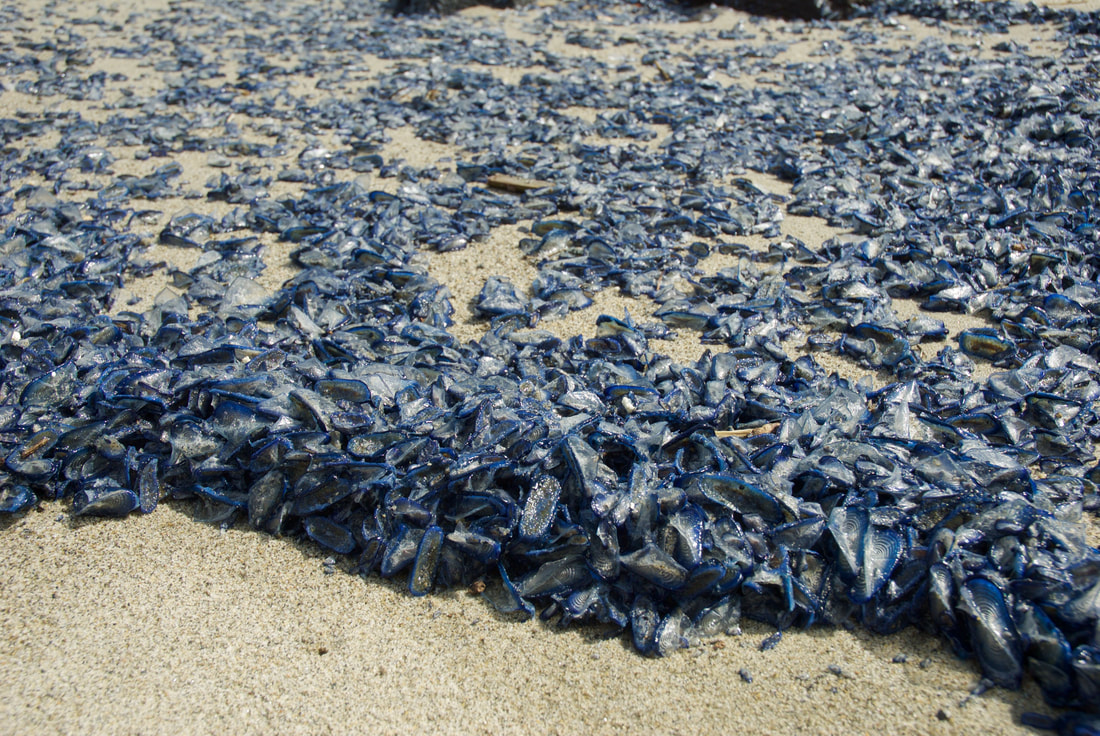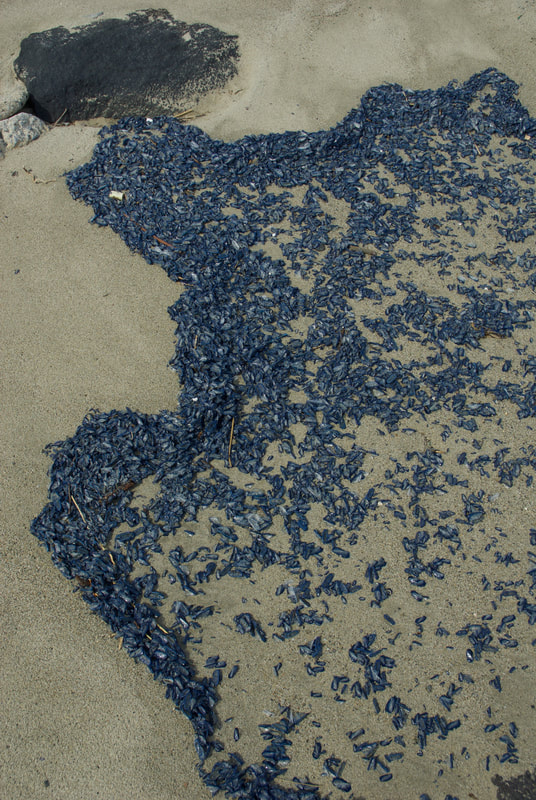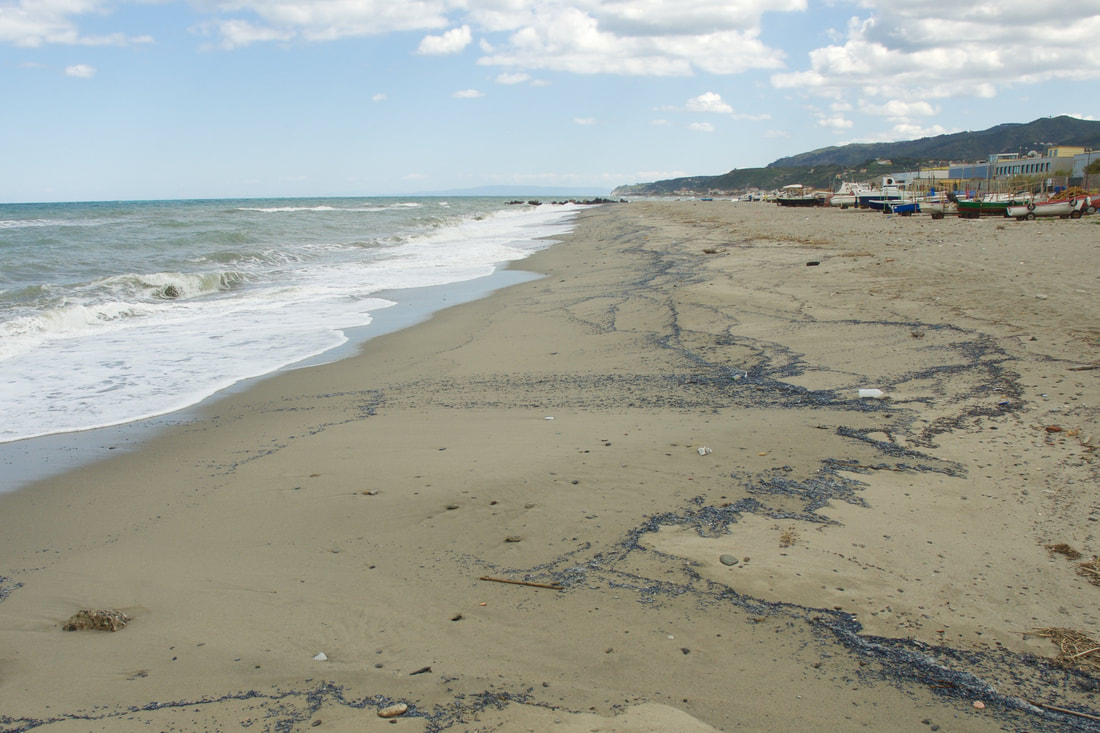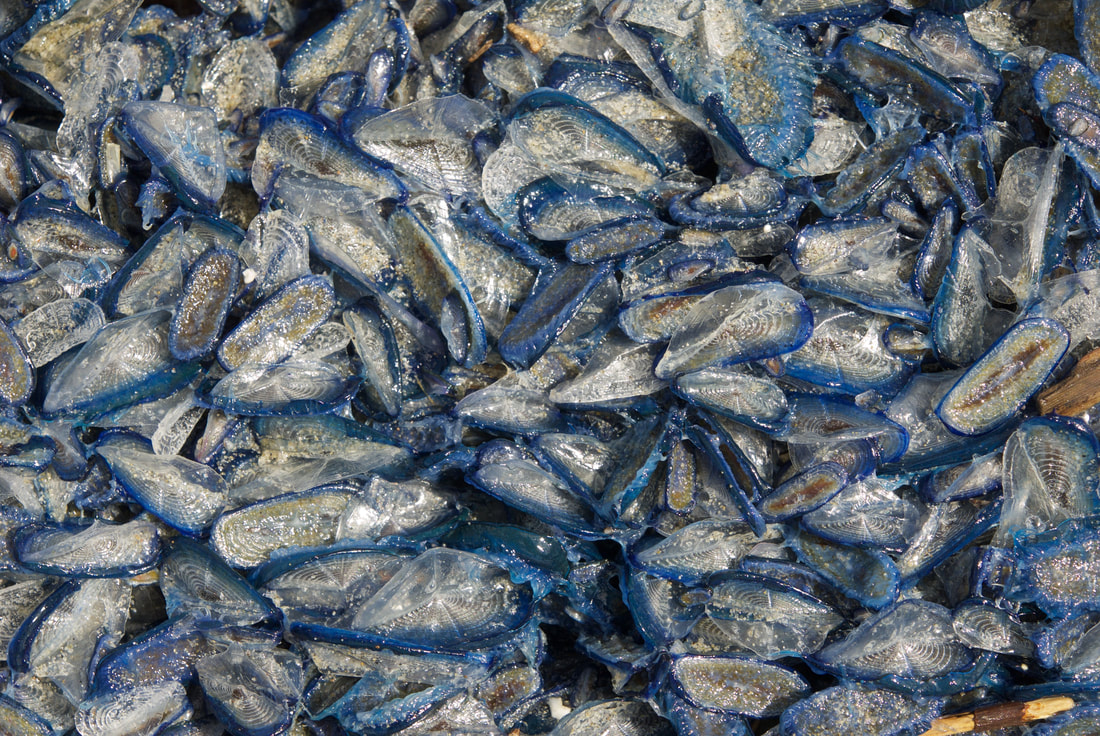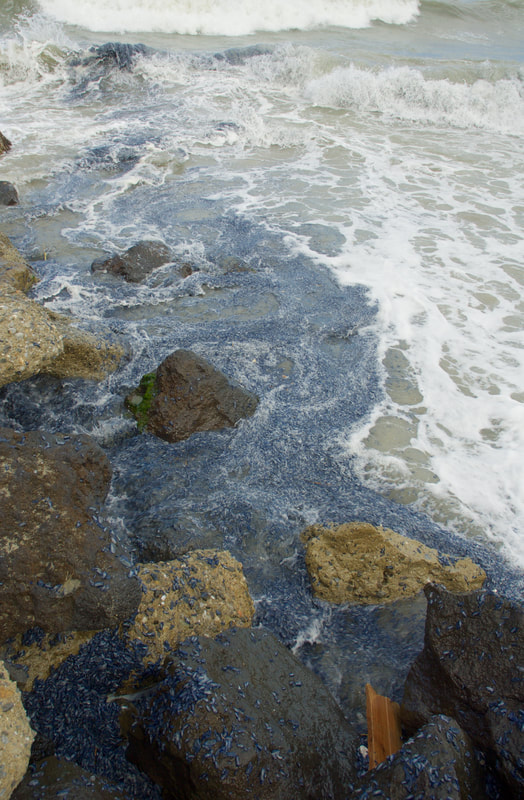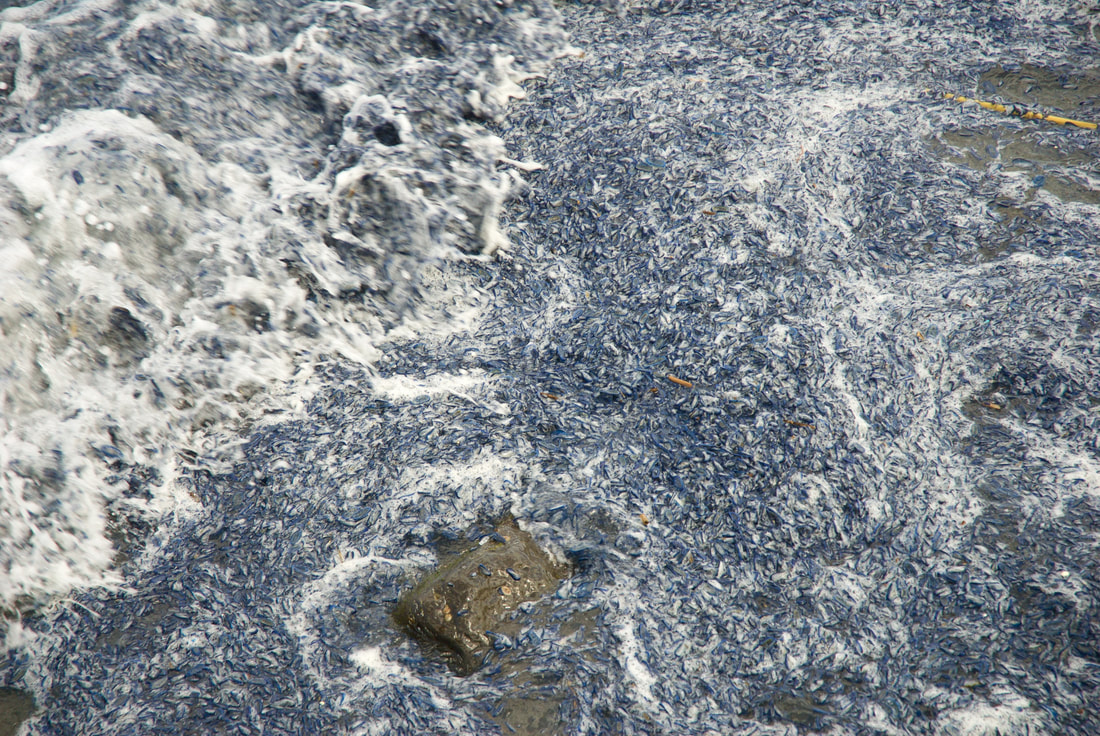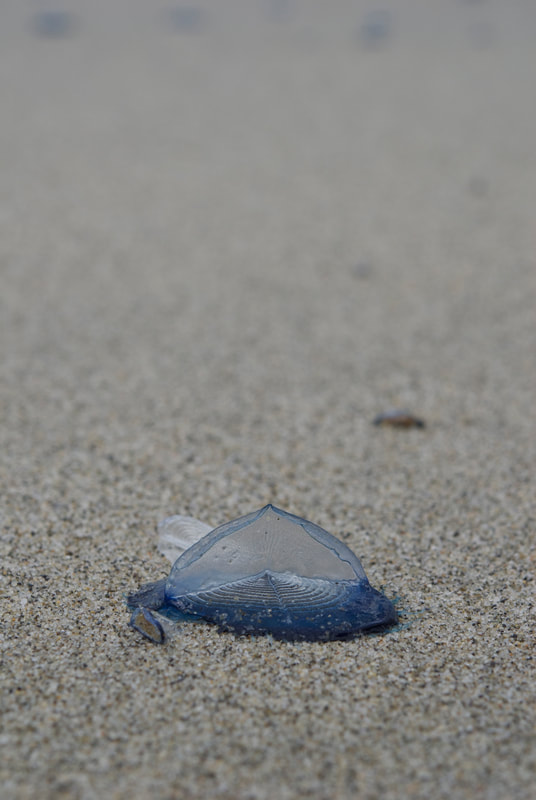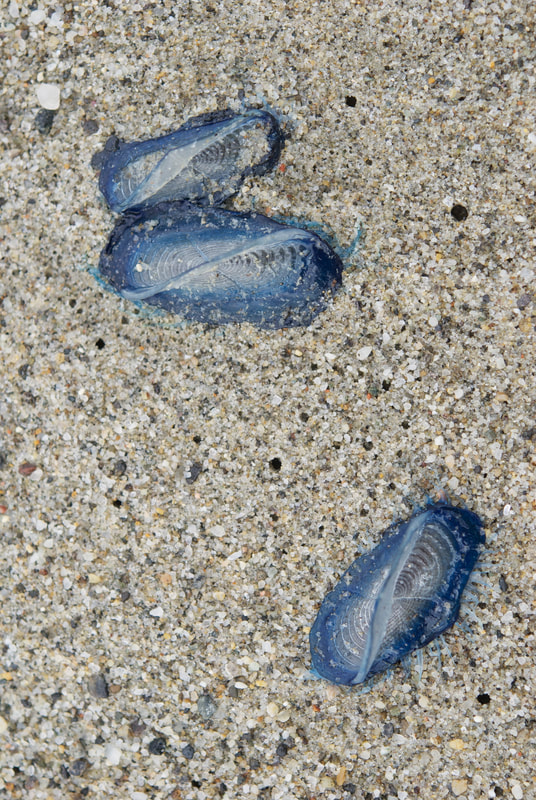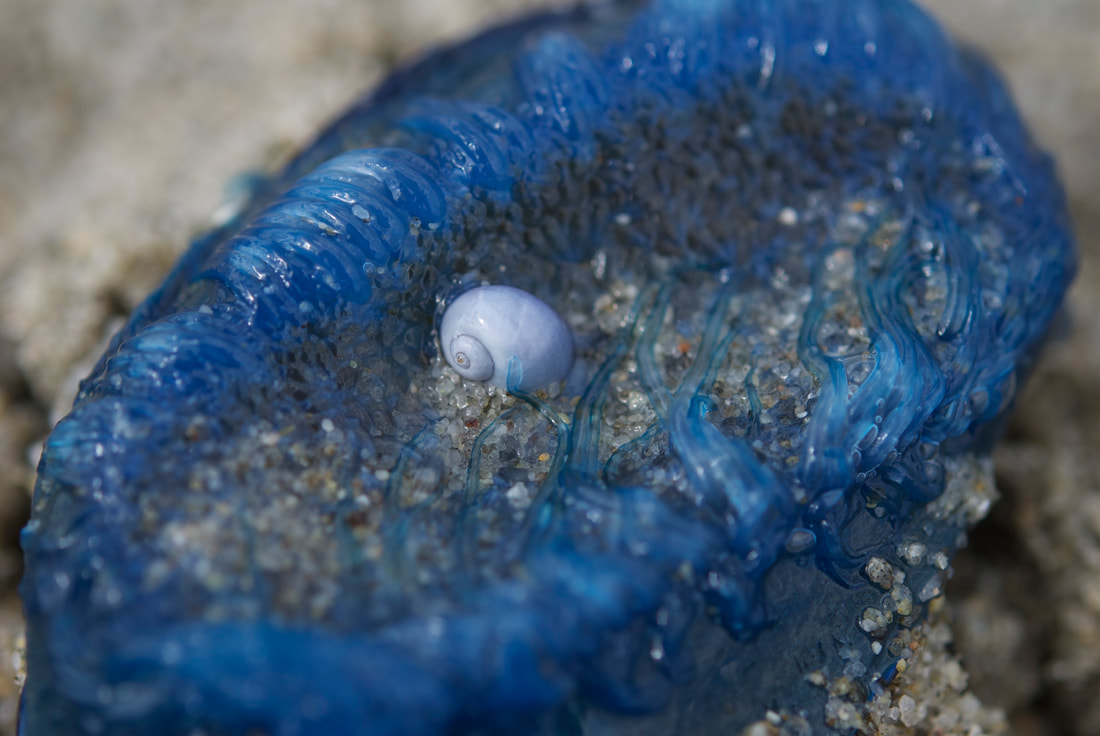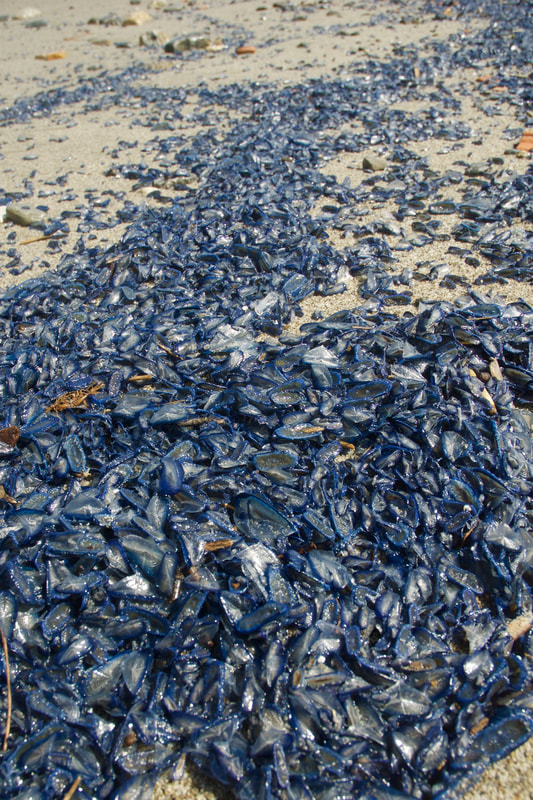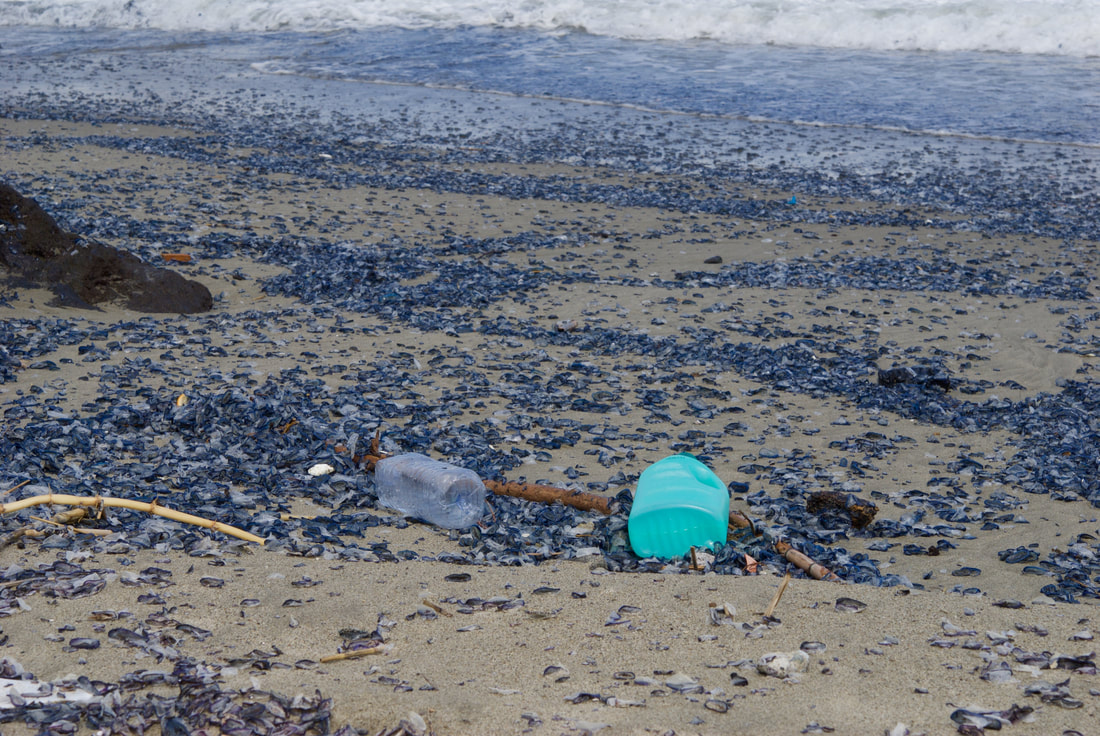A mass stranding of Velella velella (Linnaeus, 1758), the by-the-wind-sailor, north-east Sicily, April 2015.
This is a record of a mass stranding of the by-the-wind-sailor in Villafranca Tirrena, north-east Sicily, on the 7th and 8th April 2015. Continuous belts strung out along the foreshore for almost two kilometres were seen, thick with individuals in places and spread more thinly in others (Figures 1-4). In the sea, the organisms appeared to cluster into short strings as they were blown onshore but in places large numbers were corralled against short rock groynes protecting the beaches. In these areas chaotic masses were pulped into a frothy soup (Figures 5-6). It is likely that the actual extent of the stranding was greater than the length of shore I was able to walk. In fact, I subsequently found reports online which indicated that the same event was occurring more widely in the Tyrrhenian Sea at that time. Kropp (1931) based at the Stazione Zoologica, Naples, reports that in the Mediterranean the months of March and April are exactly when huge numbers of the species can occur. He notes in particular that, ‘on the beaches in Sicily’ they are washed up, ‘in such large numbers’ that they, ‘form a broad blue line hundreds of yards in length’.
The pleustonic cnidarian Velella Lamarck, 1801, in the Family Porpitidae Goldfuss, 1818 is a monotypic genus the sole representative of which is Velella velella (Linnaeus, 1758), the by-the-wind-sailor (Kemp 1986; Schuchert 2015; WoRMS 2015). Pleuston derives from the Greek word for sailing, 'pleusis', and thus itself provides a good indication of the travel arrangements for the organisms that litter the sea-air interface. These small travellers call the ocean home and for part of their life cycle they form characteristic chambered blue ovoid floats topped with a rigid transparent semi-circular-triangular chitinous sail that runs diagonally across their length (Figures 7-8). With this they can hitch a ride on any breath of wind that happens by.
What's in a name?
In Italy the common name for Velella velella is 'la barchetta di San Pietro', or 'the small boat of Saint Peter'. The north Italian rural tradition associated with this name is concerned with sails which might form overnight in water seeded with egg albumen. The presence of sails in this mythology indicates a good harvest to come (WoRMS 2015; Wikipedia 2015a). The English common name is perhaps more direct and functional, reflecting our maritime heritage, but has its own poetic resonance given the reference to sailors.
In applying the same scientific name to both the genus and the species, Linnaeus (1758) erects a clear sign-post to the defining feature of these little hydranths. The term 'hydranth' for this, the most visible stage of the life-cycle, is quite resonant, coming from the Greek word meaning 'water-flower'.
‘Velella’ derives from the Latin ‘vēlum’, meaning ‘a sail' or 'a cloth, covering, curtain or veil’ (not to be confused with the parchment, 'vellum', which, derives from 'vitulinum' meaning 'made from calf'). All the references I found while investigating the name V. velella make the link between the Latin ‘vēlum’, and its 'sail' meaning. But it may be that the original sense of 'veil' was in fact 'sail' (Skeat 1882). It is worth noting that the Italian word for a 'sail' is 'vela' and in Latin 'vēla' means 'sails' and is the plural of 'vēlum'. The etymology of ‘vēlum’ is uncertain but it may come from ‘veh-o’ which, in a passive context, means ‘to be carried or borne; to go, ride, sail, fly’ (and is akin to the Sanskrit root ‘vah’, to carry). The Roman philosopher Cicero, and the poet Virgil both use 'vēlum' in the context of 'a sail'.
In Latin the suffix '-ella' can be used as a diminutive to express smallness, affection, pity, or even contempt. A contemporary example from our own lexicon is 'novella'. The Italian Neapolitan dialect still uses '-ella' as a diminutive. In the current context it is clearly used to indicate size and thus 'velella' translates as 'small sail' and therefore V. velella would be 'small sail, small sail'.
Colouration
The incredible blue colour of the by-the-wind-sailor comes from the carotenoid pigment, astaxanthin. There are over 600 carotenoids found in plants and animals and they are the most common group of pigments found in nature forming complexes with proteins which are known as carotenoproteins (Wikipedia 2015b). These complexes are common amongst marine animals. But animals, with the exception of aphids and spider mites, are considered to be incapable of making their own carotenoids relying on plants for these pigments (Wikipedia 2015b; Wikipedia 2015c). In plants, carotenoids are involved in photosynthesis and hence can be found in the chloroplasts and other photosynthetic organisms, including some bacteria and some fungi. Aphids and spider mites are thought to have acquired the ability to make carotenoids from the genes of fungi (Wikipedia 2015c).
Astaxanthin belongs to a class of phytochemicals known as terpenes, which are hydrocarbon compounds produced by a variety of plants. V. velella has two blue astaxanthin-proteins in its mantle with about 100 carotenoids per complex. Astaxanthin is found in a range of organisms including microalgae (Wikipedia 2015d).
Algal symbionts
The tissues of V. velella contain zooxanthellae (single-celled symbiotic algae). These endosymbionts, or photobionts, have also been found in the medusa stages of V. velella (Schuchert 2010). It is probable that by-the-wind-sailors gain some nourishment from the photosynthetic activity of the dinoflagellate symbionts harbouring in their tissues. Does this source of nutrition play a critical role in survival on the open ocean or is it more ‘surplus to requirements’ when set against the food captured beneath the surface?
Gast and Caron (1996) suggest that radiolarian symbionts are most closely related to the dinoflagellate symbiont from the oceanic chondrophore, V. velella. It is generally understood that algal symbionts of radiolaria can carry out rapid rates of photosynthesis, and that a substantial portion of carbon fixed by photosynthesis is translocated to the host. In return, the host supplies its endosymbionts with inorganic nutrients derived from its waste products, and a stable environment for growth and reproduction.
Dinoflagellates currently reported as being found in V. velella studied from various geographic locations around the world include Endodinium chattonii Hovasse 1922; Scrippsiella velellae Banaszak, Iglesias-Prieto & Trench, 2000; and, Zooxanthella nutricula Brandt.
Janthina janthina (Linnaeus, 1758)
As I walked the length of the shore at Villafranca Tirrena I kept a look out for the pelagic mollusc Janthina janthina (the violet snail or bubble raft shell). The species is a known predator of V. velella. Obviously, my search was not exhaustive but nevertheless across that two kilometres of coast I managed to turn up just one individual, still attached to its prey (Figure 9).
Organic matter input to near-shore environments
As a final thought it's worth noting that Kemp (1986) suggested such strandings as this may form a brief but major input of organic matter to beaches and near-shore environments (Figures 10 and 11). What the energetic importance of this might be is difficult to say and would depend, for example, on just how much of that potential biomass actually remained in the local system. However, as Kemp states, “If mass strandings materially affect production, they would constitute a stochastic perturbation which may contribute to inter-annual variation in sand beach systems.”
In Italy the common name for Velella velella is 'la barchetta di San Pietro', or 'the small boat of Saint Peter'. The north Italian rural tradition associated with this name is concerned with sails which might form overnight in water seeded with egg albumen. The presence of sails in this mythology indicates a good harvest to come (WoRMS 2015; Wikipedia 2015a). The English common name is perhaps more direct and functional, reflecting our maritime heritage, but has its own poetic resonance given the reference to sailors.
In applying the same scientific name to both the genus and the species, Linnaeus (1758) erects a clear sign-post to the defining feature of these little hydranths. The term 'hydranth' for this, the most visible stage of the life-cycle, is quite resonant, coming from the Greek word meaning 'water-flower'.
‘Velella’ derives from the Latin ‘vēlum’, meaning ‘a sail' or 'a cloth, covering, curtain or veil’ (not to be confused with the parchment, 'vellum', which, derives from 'vitulinum' meaning 'made from calf'). All the references I found while investigating the name V. velella make the link between the Latin ‘vēlum’, and its 'sail' meaning. But it may be that the original sense of 'veil' was in fact 'sail' (Skeat 1882). It is worth noting that the Italian word for a 'sail' is 'vela' and in Latin 'vēla' means 'sails' and is the plural of 'vēlum'. The etymology of ‘vēlum’ is uncertain but it may come from ‘veh-o’ which, in a passive context, means ‘to be carried or borne; to go, ride, sail, fly’ (and is akin to the Sanskrit root ‘vah’, to carry). The Roman philosopher Cicero, and the poet Virgil both use 'vēlum' in the context of 'a sail'.
In Latin the suffix '-ella' can be used as a diminutive to express smallness, affection, pity, or even contempt. A contemporary example from our own lexicon is 'novella'. The Italian Neapolitan dialect still uses '-ella' as a diminutive. In the current context it is clearly used to indicate size and thus 'velella' translates as 'small sail' and therefore V. velella would be 'small sail, small sail'.
Colouration
The incredible blue colour of the by-the-wind-sailor comes from the carotenoid pigment, astaxanthin. There are over 600 carotenoids found in plants and animals and they are the most common group of pigments found in nature forming complexes with proteins which are known as carotenoproteins (Wikipedia 2015b). These complexes are common amongst marine animals. But animals, with the exception of aphids and spider mites, are considered to be incapable of making their own carotenoids relying on plants for these pigments (Wikipedia 2015b; Wikipedia 2015c). In plants, carotenoids are involved in photosynthesis and hence can be found in the chloroplasts and other photosynthetic organisms, including some bacteria and some fungi. Aphids and spider mites are thought to have acquired the ability to make carotenoids from the genes of fungi (Wikipedia 2015c).
Astaxanthin belongs to a class of phytochemicals known as terpenes, which are hydrocarbon compounds produced by a variety of plants. V. velella has two blue astaxanthin-proteins in its mantle with about 100 carotenoids per complex. Astaxanthin is found in a range of organisms including microalgae (Wikipedia 2015d).
Algal symbionts
The tissues of V. velella contain zooxanthellae (single-celled symbiotic algae). These endosymbionts, or photobionts, have also been found in the medusa stages of V. velella (Schuchert 2010). It is probable that by-the-wind-sailors gain some nourishment from the photosynthetic activity of the dinoflagellate symbionts harbouring in their tissues. Does this source of nutrition play a critical role in survival on the open ocean or is it more ‘surplus to requirements’ when set against the food captured beneath the surface?
Gast and Caron (1996) suggest that radiolarian symbionts are most closely related to the dinoflagellate symbiont from the oceanic chondrophore, V. velella. It is generally understood that algal symbionts of radiolaria can carry out rapid rates of photosynthesis, and that a substantial portion of carbon fixed by photosynthesis is translocated to the host. In return, the host supplies its endosymbionts with inorganic nutrients derived from its waste products, and a stable environment for growth and reproduction.
Dinoflagellates currently reported as being found in V. velella studied from various geographic locations around the world include Endodinium chattonii Hovasse 1922; Scrippsiella velellae Banaszak, Iglesias-Prieto & Trench, 2000; and, Zooxanthella nutricula Brandt.
Janthina janthina (Linnaeus, 1758)
As I walked the length of the shore at Villafranca Tirrena I kept a look out for the pelagic mollusc Janthina janthina (the violet snail or bubble raft shell). The species is a known predator of V. velella. Obviously, my search was not exhaustive but nevertheless across that two kilometres of coast I managed to turn up just one individual, still attached to its prey (Figure 9).
Organic matter input to near-shore environments
As a final thought it's worth noting that Kemp (1986) suggested such strandings as this may form a brief but major input of organic matter to beaches and near-shore environments (Figures 10 and 11). What the energetic importance of this might be is difficult to say and would depend, for example, on just how much of that potential biomass actually remained in the local system. However, as Kemp states, “If mass strandings materially affect production, they would constitute a stochastic perturbation which may contribute to inter-annual variation in sand beach systems.”
References
Ager, O.E.D. (2008). Velella velella By-the-wind-sailor. In Tyler-Walters H. and Hiscock K. (eds) Marine Life Information Network: Biology and Sensitivity Key Information Reviews, [on-line]. Plymouth: Marine Biological Association of the United Kingdom. Available from: http://www.marlin.ac.uk/species/detail/1802.
Gast, R.J. and Caron, D.A. (1996). Molecular phylogeny of symbiotic dinoflagellates from planktonic foraminifera and radiolarians. Mol Biol Evol. 13(9), 1192-7.
Kemp P.F. (1986). Deposition of organic matter on a high-energy sand beach by a mass stranding of the cnidarian Velella velella (L.). Estuarine and Coastal Shelf Science, 23(4), 575–579.
Kropp, B. (1931). The Pigment of Velella spirans and Fiona marina. Biological Bulletin, 60(2), 120-123. DOI: 10.2307/1537023.
Schuchert, P. (2010). The European athecate hydroids and their medusae (Hydrozoa, Cnidaria): Capitata Part 2. Revue Suisse de Zoologie, 117: 337-555. page(s): 476.
Schuchert, P. (2015). Velella. In: Schuchert, P. (2015) World Hydrozoa database. Accessed through: World Register of Marine Species at http://www.marinespecies.org/aphia.php?p=taxdetails&id=117200 on 2015-12-31.
Skeat, W. W. (1882). The Concise Dictionary of English Etymology (1993): The pioneering work on the roots and origins of the language. Wordsworth Reference. First published in 1882.
Wikipedia (2015a). Barca di San Pietro. Available online at: https://it.wikipedia.org/wiki/Barca_di_San_Pietro. Accessed December 2015.
Wikipedia (2015b). Biological pigment. Available online at: https://en.wikipedia.org/wiki/Biological_pigment#Pigments_in_plants. Accessed January 2016.
Wikipedia (2015c). Carotenoids. Available online at: https://en.wikipedia.org/wiki/Carotenoid. Accessed December 2015.
Wikipedia (2015d). Astaxanthin. Available online at: https://en.wikipedia.org/wiki/Astaxanthin. Accessed December 2015.
WoRMS 2015. Velella velella (Linnaeus, 1758). In: Schuchert, P. (2015) World Hydrozoa database. Accessed through: World Register of Marine Species at http://www.marinespecies.org/aphia.php?p=taxdetails&id=117832 on 2015-12-28.
Citation: This article was originally published in the Spring 2016 edition of the Bulletin of the Porcupine Marine Natural History Society and can be cited as follows:
Barfield, P. D. (2016). A mass stranding of Velella velella (Linnaeus, 1758), the by-the-wind-sailor, north-east Sicily, April 2015. Bulletin of the Porcupine Marine Natural History Society, No. 5, 26-29. ISSN 2054-7137.
© Sea-nature Studies, 2016. All rights reserved in all media.
Ager, O.E.D. (2008). Velella velella By-the-wind-sailor. In Tyler-Walters H. and Hiscock K. (eds) Marine Life Information Network: Biology and Sensitivity Key Information Reviews, [on-line]. Plymouth: Marine Biological Association of the United Kingdom. Available from: http://www.marlin.ac.uk/species/detail/1802.
Gast, R.J. and Caron, D.A. (1996). Molecular phylogeny of symbiotic dinoflagellates from planktonic foraminifera and radiolarians. Mol Biol Evol. 13(9), 1192-7.
Kemp P.F. (1986). Deposition of organic matter on a high-energy sand beach by a mass stranding of the cnidarian Velella velella (L.). Estuarine and Coastal Shelf Science, 23(4), 575–579.
Kropp, B. (1931). The Pigment of Velella spirans and Fiona marina. Biological Bulletin, 60(2), 120-123. DOI: 10.2307/1537023.
Schuchert, P. (2010). The European athecate hydroids and their medusae (Hydrozoa, Cnidaria): Capitata Part 2. Revue Suisse de Zoologie, 117: 337-555. page(s): 476.
Schuchert, P. (2015). Velella. In: Schuchert, P. (2015) World Hydrozoa database. Accessed through: World Register of Marine Species at http://www.marinespecies.org/aphia.php?p=taxdetails&id=117200 on 2015-12-31.
Skeat, W. W. (1882). The Concise Dictionary of English Etymology (1993): The pioneering work on the roots and origins of the language. Wordsworth Reference. First published in 1882.
Wikipedia (2015a). Barca di San Pietro. Available online at: https://it.wikipedia.org/wiki/Barca_di_San_Pietro. Accessed December 2015.
Wikipedia (2015b). Biological pigment. Available online at: https://en.wikipedia.org/wiki/Biological_pigment#Pigments_in_plants. Accessed January 2016.
Wikipedia (2015c). Carotenoids. Available online at: https://en.wikipedia.org/wiki/Carotenoid. Accessed December 2015.
Wikipedia (2015d). Astaxanthin. Available online at: https://en.wikipedia.org/wiki/Astaxanthin. Accessed December 2015.
WoRMS 2015. Velella velella (Linnaeus, 1758). In: Schuchert, P. (2015) World Hydrozoa database. Accessed through: World Register of Marine Species at http://www.marinespecies.org/aphia.php?p=taxdetails&id=117832 on 2015-12-28.
Citation: This article was originally published in the Spring 2016 edition of the Bulletin of the Porcupine Marine Natural History Society and can be cited as follows:
Barfield, P. D. (2016). A mass stranding of Velella velella (Linnaeus, 1758), the by-the-wind-sailor, north-east Sicily, April 2015. Bulletin of the Porcupine Marine Natural History Society, No. 5, 26-29. ISSN 2054-7137.
© Sea-nature Studies, 2016. All rights reserved in all media.
| pmnhsbull5_btws.pdf |
